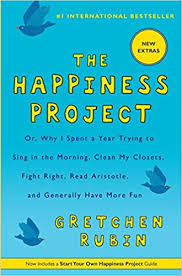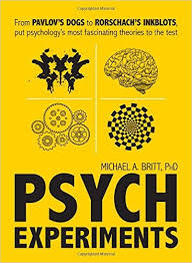Author: Gretchen Rubin
ISBN: 978-0-06-158326-1
APA Style Citation
Rubin G. (2009). The Happiness Project. New York: Harper Collins Publishers.
| gratitude_journal_2.pdf |
Gretchen Rubin lives in New York with her husband and two young daughters. As she describes the impetus for the project, she explains what while she is certainly not unhappy, she wanted to embark on a year-long project to allow her to appreciate all of the good things in her life better. Positive psychologist Sonya Lyubomirsky suggests that about 50% of people’s happiness is genetic, and about 10-20 percent is a product of how a person thinks and acts, it is this 10-20% that Gretchen wants to improve in her own life. Rubin is careful to indicate that everyone’s happiness project will be different and what works for her may not work for others. Rubin selects a different project for each month while trying to maintain each previous months resolution as well. An instant challenge to getting started in her project is defining happiness. Many researchers have tried to define what it means to be happy, but it in large part remains highly subjective to each individuals experience. While The Happiness Project is unique to Gretchen and her decisions to the monthly projects she undertakes are rooted in research.
January’s goal was to boost energy, Rubin’s explains that if she does not have energy, she will not have the ability she will need to maintain her projects throughout the year. Rubin tried to increase her energy by buying a pedometer to encourage her to walk and exercise a bit more, she also joined a gym focused on strength training, and despite her initial hesitation, she found that she enjoyed the workouts. She also decided to reduce clutter, which often simplifies people’s daily choices. Rubin cleaned out her closet, eliminating for example 2 of the five pairs of black pants she knows she will never wear. This decluttering made her morning selection for clothing easier each day, and she claims she feels better because all of her options are her favorite options. She also devotes five minutes each night to tidying which helps to wake up to a cleaner house in the morning. With a bit more energy (and perhaps a bit more muscle) she was able to tackle the rest of the year.
February was devoted to remembering to love; she wanted to nag to her children and husband less about chores and to be less dependent on receiving praise for everything she does for her family. She vowed to “fight fair” and go one “date night” with her husband even if that meant staying at home watching a movie together after their children were sleeping. Rubin knows that happier people tend to be more forgiving, helpful and charitable and Rubin believes this can also work in reverse. Rubin also clearly recognizes that when she is happy, her family is also happier. Rubin takes the initiative to plan her mother-in-law’s birthday party instead nagging her husband and father-in-law to get it done and as a result creates a party that Rubin knows her mother-in-law loved.
In March she arrives at her first splendid truth, “To be happy, I need to think about feeling good, feeling bad, and feeling right, in an atmosphere of growth.” In this idea of growth, Rubin devoted March to aiming higher. Rubin wanted to stretch herself to try something new and to overcome the fear of failure. She started a blog after taking a recommendation from a friend. While she struggled at first with some of the technology, she has fun and still maintains the blog and has also more recently branched out to podcasts (see resources). When pushing one’s self, Rubin also recognized that she needs to ask for help. In March Rubin embraces one of the main principles of much happiness research, which emphasizes to enjoy the present instead of wishing things would be different in the future.
Rubin emphasized parenthood in April, she tried to remain patient with her children and actively engaged in games and activities she knew they would enjoy. Rubin committed to singing in the morning to start the day out on the right foot. Rubin also began to take more photographs of happy moments to remind her later of those great times.
The goal in May was to be serious about play and take the time to be silly. Rubin goofs around with her children, remembers her earlier promise to nag less often and begins a reading group with others who enjoy children’s literature. She recommits to doing things that make her happy without worrying about whether or not it is what others would do to be happy. She faces this often, advice from others who suggest she see a therapist, or that her project is silly or have other recommendations on what she needs to do to be successful in her happiness project. She keeps reminding herself and the reader that “you know yourself best” and should do what you know will make you happy, not what others believe will make you happy.
In June, Rubin committed to making time for friends, because she is so busy this does not always mean meeting up with friends face to face. She tracks down an old high school friend, and they catch up for a few hours, she updates her address book so she can be sure to send a holiday card once a year to keep the communication open. She uses Facebook to remember birthdays. Rubin also finds the benefits of the route to happiness through generosity by volunteering to serve as a mentor for a high school student. June also meant a refrain from gossip and showing up at social events that would otherwise be easy skip. Rubin makes the commitment to make three new friends, and while this seems contrived, it had the effect or making Rubin more outgoing whether mingling with people at a dinner party or her daughter's school and this alone makes her happier. She describes that it is easy to say you do not have time for three more friends but she claims that these do not have to be connections that one sees once a week or even once a month, but just maybe to meet up for a coffee or a quick conversation or e-mail.
Halfway through her happiness project, Rubin assessed whether she was happier and she decides that in fact, she is, although she cannot say specifically why she is happier. She also is honest about her difficult days during which all of her goals seem pointless. Her daughters have temper tantrums, she finds herself frustrated with her husband but when she gets off track she does not give up, she simply tries to do better the next day. One of Rubin’s guidelines for increasing happiness is allowing one’s self to experience failure. She acknowledges her failures and looks forward.
While much research has suggested that money does not directly correlate to happiness, there is a modest correlation. Once a person is able to have the things they need to pay bills and not worry about money the correlation seems to plateau (generally over about $100,000). Rubin dedicates July to buying some happiness and allows herself modest splurges. She indicates that she is not much of a shopper and decides on a professional photography session for her family, which she used as gifts for grandparents and these photographs give her much more happiness. Rubin recognizes that money impacts people differently and there may be some who enjoy collecting expensive wine or art, so the personal differences of happiness are once again important in creating happiness. Rubin also recognizes that giving something up may make one happier because the gratitude of having the desired object may be worth the wait.
In August Rubin kept a gratitude journal (see activity) to help her recognize the many blessings that she has that often go unnoticed. She eventually finds that simply thinking about things that she is grateful for each day works better for her than writing these down each day. She is in good health, has a good relationship with her in-laws, lives in a city she loves, in an apartment he loves and has a happy, healthy family. She finds herself in extreme back pain and after she sees a chiropractor that solves the problem she comes to appreciate her good health that she may have previously taken for granted. She also reads biographies about catastrophes which rather than making her sad, make her appreciate all that she has. While Rubin is not particularly religious, she recognizes that others may get much satisfaction from a more spiritual approach to happiness. She does find inspiration from Sister Therese from France who treated even those that she did not like with the utmost kindness. Other nuns commented that she was naturally happy and kind, but her own diaries indicated how hard she worked to make it seem effortless. Rubin tries to emulate Sister Therese but is still working hard on this commitment.
In September Rubin committed to pursuing a passion, and she writes a novel of over 50,000 words by writing a little bit each day. While she indicates, the novel needs much revision she expresses the satisfaction associated with completing a task from start to finish in such a short period. Rubin loves books and stories and commits to finding even small moments of time to read or reread books she loved; this is her passion. She masters a new technology by making Shutterfly books of her children’s events and a happiness box for each of her daughters which has the effect of cleaning up clutter and keeping special mementos for her daughters.
October’s goal was to pay attention. Rubin tried hypnosis and commits to spending more time devoted to interacting with her daughters and her husband. She tried to be in less of a hurry and be more patient. She took an art class and improved significantly in a single week. Rubin kept a food diary for a short while to eat healthier but found she was more successful in trying to eat less processed food.
In November, Rubin made an effort to laugh out loud, and while she found a laughter club was not for her she did try to laugh more with her family, and she reported feeling better. To wrap up her year, December was devoted to boot camp perfecting each of her previous goals.
Rubin’s year long project contains both success and failure. She acknowledges that for each person who might want to engage in a similar project, their activities will be different and tailored to their own interests and challenges. Even if it is just one project that increases appreciation for one’s life, it might be worth the effort. On Rubin’s website, there is more information regarding how to start your own happiness project.
Other Related Resources
The Happiness Project Website
(Including the blog, podcasts, information on starting your own happiness project, etc.)
http://gretchenrubin.com
Psychology Today Article on the Happiness Project
https://www.psychologytoday.com/blog/the-happiness-project
Sticther Podcast with Gretchen Rubin
https://www.stitcher.com/podcast/happier-with-grechen-rubin
The Goodlife Project
How to Build habits that change lives
http://www.goodlifeproject.com/gretchen-rubin/
The Minimalist Project
The Minimalist Project advocate simplifying one’s life to make live more genuinely and more happily.
http://www.theminimalists.com
Psychological Figures and Concepts
Dali Lama
John Stuart Mill
Adaptation level phenomenon
Big Five personality trait (openness, conscientiousness, extroversion, agreeableness, neuroticism)
Facial feedback hypothesis
Feel-good-do-good phenomenon
Fundamental attribution error
Hypnosis
Mere exposure effect
Nature vs. nurture
Reciprocity
Relative deprivation
Upward social comparison


 RSS Feed
RSS Feed